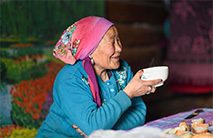Feature: Dual-Olympic city Beijing carries forward Olympic dream
BEIJING, Feb. 2 (Xinhua) -- For many people across the world, Beijing may just be China's capital city with abundant historical and cultural heritage.
But to many Chinese, it is an enduring symbol of the Olympics - the first city in the world to have hosted both summer and winter Olympic Games. It preserves the Olympic spirit and carries forward the Olympic dream.
FASTER, CLEANER AND MORE EXPERIENCED
Xu Xin first came to Beijing as an 18-year-old in 1997 to enrol at Beijing Foreign Studies University.
"My first impression was that there were so many opportunities in Beijing, especially for a language-learning student like me," he recalled.
He majored in Swedish. In summer 2001, when the entire city was in ecstasy after winning the bid to host the 2008 Olympics, Xu graduated.
A total of 74,615 volunteers from 98 countries and regions helped the organization of the 2008 Olympics, including Xu, who provided translation service for Team Sweden at the Olympic Village. He watched several competitions during the Games, met famous athletes and even had a photo with the late Kobe Bryant.
Those were busy happy days and Xu always wears a big smile talking about his Beijing 2008 experience. After the Olympics, he revisited the venues for different purposes, a recent one being to the Wukesong Arena, which had hosted basketball matches then, for a concert.
He also witnessed the development of Beijing, where the public transportation network expanded and the city became cleaner.
Now Xu became an Olympic volunteer for the second time. "It is unbelievable that my city could host a second Olympics after just more than a dozen years, and I am lucky to become a volunteer at both events," he said.
The 2022 Winter Olympics and Paralympics have, respectively, 27,000 and 12,000 volunteers, selected from more than one million candidates.
Xu saw many young faces in the volunteer team. "I felt like seeing myself in 2008," he said.
Driving on the roads of Beijing, he found some signs of 2008 Olympic lanes still visible, while at some other sections, signs for the 2022 special lane have already been put up.
"In the past 14 years, the telecommunication technology in our country has developed quickly, which made communication easier. China has more experience in hosting major events, and I am sure the service of volunteers will be even better this time."
FROM GRANDEUR TO SUSTAINABILITY
While Xu Xin is busy learning the terminology of winter sports, Li Jiulin awaits a test at the National Speed Skating Oval, dubbed the Ice Ribbon. Li was the chief engineer of its construction.
The Oval is located in north Beijing, about 3.5 kilometers away from the National Stadium, also known as the Bird's Nest, where the opening ceremony of the 2008 Beijing Olympics presented Chinese culture to the world 14 years ago.
When Li became an engineer at the Bird's Nest in 2003, he was 35.
The 80,000-capacity stadium was known as the world's largest steel structure.
"The building of Beijing's National Stadium launched a new era in China's construction industry and has drawn a variety of innovations, many of which have been upgraded in the following years and applied to the National Speed Skating Oval," he said.
Six of the venues from the 2008 Olympics are being used for the 2022 Winter Games in a bid to cut costs. The Ice Ribbon is the only ice-sport venue built from scratch for the 2022 Winter Olympics.
Beijing 2022 has pledged to deliver a green, sustainable and low-carbon Games, so Li and his team had to tackle a series of technical problems to reduce the use of steel. The Ice Ribbon boasts the most extensive full ice design in Asia, with an ice surface area of 12,000 square meters. Carbon dioxide refrigerant was introduced for ice-making, which is the most environmentally-friendly natural refrigerant, in an effort to reduce damage to the ozone layer.
In Li's team, about one-third of the people involved had, like him, worked in construction for both the summer and winter Games.
"Olympic stadiums showed the strength of a nation in certain eras," he said. "The Bird's Nest impressed visitors with its grandeur, while the new Ice Ribbon reflected the new characteristics in development: sustainability."
"It is an honor for me to be involved in the construction of both," he added with a grin.
START OF A DREAM
Former skater Yu Yongjun will be among the audience when the Olympic short track speed skating action gets underway this week in the Capital Gymnasium.
The World Cup gold medalist started short-track skating in 2001 when Beijing won the bid for the 2008 Summer Games.
"I remembered well people's celebrations then," Yu said. "I knew that the Olympics was the most important stage for athletes and dreamed of competing there one day."
In the following years, he witnessed the preparation of the 2008 Olympics until the 29 giant footprints outlined in fireworks lit up Beijing's summer night sky to unveil the long-awaited sports gala.
The 2008 Olympics sparked ordinary people's passion for sports.
The following year, in 2009, Yu was selected by China's national short track speed skating team. He finished runner-up in the 1,000-meter event at the Quebec World Cup in the 2010/2011 season, and won gold medals in the 5,000-meter relay along with teammates in the 2011/2012 Shanghai and Nagoya World Cups.
But just when everything seemed to be going in the right direction, he was struck down by injuries. He missed the Sochi Olympics in 2014 and retired.
But his Olympic dream lives on in another form.
After spending two years learning overseas, he moved to China's southern province of Yunnan to promote winter sports, setting up the provincial short track skating team. Yu came back to Beijing and was appointed assistant coach of the national team in 2018.
In 2020, he joined a skating club in Beijing's Yanqing district called Mengqiyuan, which means "start of a dream." He gave lessons to local primary and middle school students at the club and helped train school teams.
He also coaches 16 trainees who are pursuing their sports dream, just as he did before.
"In our generation, short track skaters were mostly from northeast China where winter sports were popular," Yu recalled. But his trainees were from different parts of the country, including the warm southwestern provinces like Yunnan and Sichuan.
His students and trainees were among the 346 million Chinese people who have participated in winter sports activities since Beijing's successful bid for the 2022 Winter Olympics in 2015, according to China's National Bureau of Statistics.
China now has 654 standard ice rinks, an increase of 317 percent from 2015. The number of indoor and outdoor ski resorts reached 803, up from 568 resorts in 2015.
Yu said that he expected Yanqing to become a base of short track skating in China.
He hopes that one day, his students could, as he had dreamed as a child, skate in the Olympic arena. But he also would like to see more people embracing winter sports. "May the Winter Games be the start of their dream."
Photos
Related Stories
- Beijing 2022 Olympic Torch Relay kicks off
- A peek at the Beijing Winter Olympic Village
- Meet China's Winter Olympics venues
- When Olympic test event meets Spring Festival
- Beijing gears up for Olympic test event
- Twists and Turns of Baiwei's Way
- China's figure skating pair confident for 2022
- Beijing's vast pool of experienced professionals help guarantee successful Games delivery
- Olympics end with a triumphant host - Canada
- China wins women's 3,000m short track relay with world record
- Nikita Kruikov won men's cross country skiing individual sprint classic
Copyright © 2022 People's Daily Online. All Rights Reserved.










